¶ Introduction
This documentation deals with going-around when flying under instrument flight rules. It will in particular describe how a missed approach is structured and it will bring practical aspects about going-around when operating under IFR.
The expression "missed approach" only applies to IFR flights and is irrelevant to VFR flights. Note that a specific document exists for flights under visual flight rules.
¶ Regulations
¶ Missed approach structure
Extract from ICAO Doc 8168: "During the missed approach phase of the instrument approach procedure, the pilot is faced with the demanding task of changing the aircraft configuration, attitude and altitude. For this reason, the design of the missed approach has been kept as simple as possible and consists of three phases (initial, intermediate and final)."
Missed approach should neither be initiated lower than the applicable (M)DA/H, nor before reaching the missed approach point (MAPt).
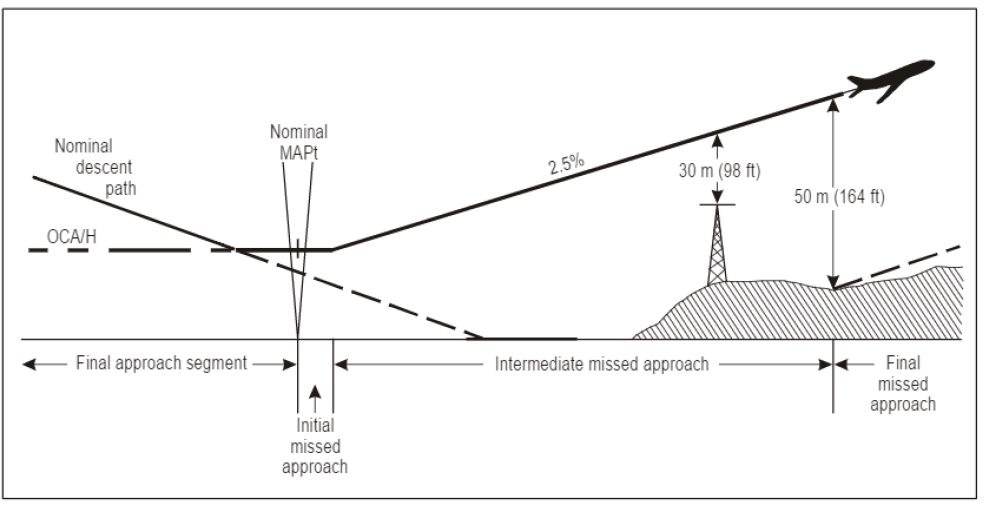
¶ Missed approach point -- MAPt
The missed approach point is the waypoint at the end of the final approach segment and at the beginning of the initial missed approach segment. It may be defined as:
- the moment at which the aircraft will reach the DA/H at the end of the descent during a precision approach (ILS, MLS, GLS, APV)
- a radio-navigation means (NDB/VOR/Marker), a specified radial-distance from a VOR/DME or a NDB/DME, or a GPS waypoint ; during non-precision approach (LOC, VOR, NDB, LNAV).
Some non-precision approaches, in particular those to be performed without DME support, include a time-based missed approach point. The pilot will start a timer when passing the final approach point. It will compare it to a provided or computed timer until the missed approach point.
When reaching the MAPt, it is expected from the pilot that he will perform the missed approach procedure immediately if he did not acquire visual references.
Failure to comply will lead to fly below safety altitudes in relation with obstacle protection.
¶ Initial segment
The initial segment of the missed approach begins at the missed approach point and ends when the aircraft has established its climb -- Start Of Climb (SOC).
No turn can be prescribed during this phase as it is assumed that guidance equipment is not used.
The concentration of the pilots should be focused on establishing the climb and changing the aircraft configuration (landing gear, flaps).
¶ Intermediate segment
The intermediate segment begins at the start of climb and ends at the first point where 50 meters / 164 feet of obstacle clearance can be maintained.
A track change of maximum 15° can be prescribed as the pilot is required to begin track correction.
¶ Final segment
The final segment begins at the point where an OCH of 50 meters can be maintained and extends until a new approach, a hold or a diversion is initiated.
Turns may be prescribed in this phase.
¶ Types of missed approaches
¶ Straight-in missed approach
Whenever practicable, the missed approach will lead to fly along the extended runway centerline until being vectored back by the ATC
Example: ILS35R - Lyon LFLL
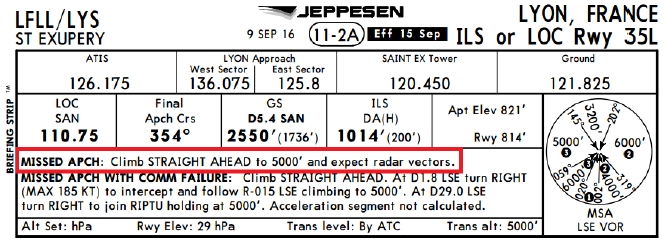
¶ Turning missed approach
When proven that the terrain is a factor, a turning missed approach will be established.
Example: LOC18 - Calvi LFKC
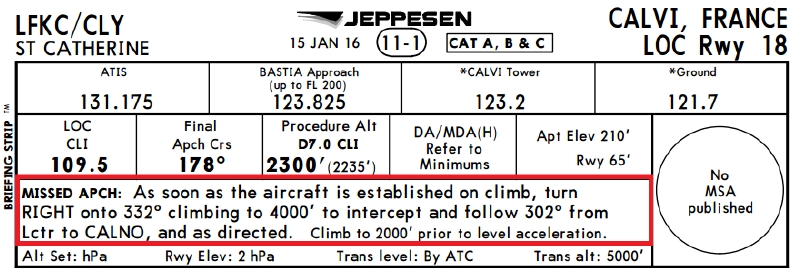
¶ Subtype: Turning point missed approach
A straight-in missed approach may include a turning point during the final segment at which a turn will be initiated. This waypoint will be a radio navigation means, an RNAV waypoint, or a radial/distance waypoint.
Example: VORDME 05L/R - Mexico MMMX.
Initiate a turn when passing 9.0DME of MEX VOR.
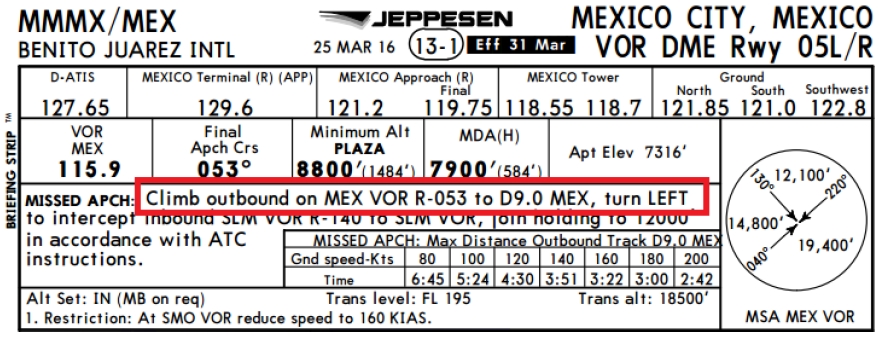
¶ Subtype: Turning altitude missed approach
A straight-in missed approach may include a turning altitude during the final segment at which a turn will be initiated. This altitude ensures generally that a safe return to the IAF may be done.
Example: NDB 25R - Jakarta WIII.
Initiate a turn when passing 2000 feet.
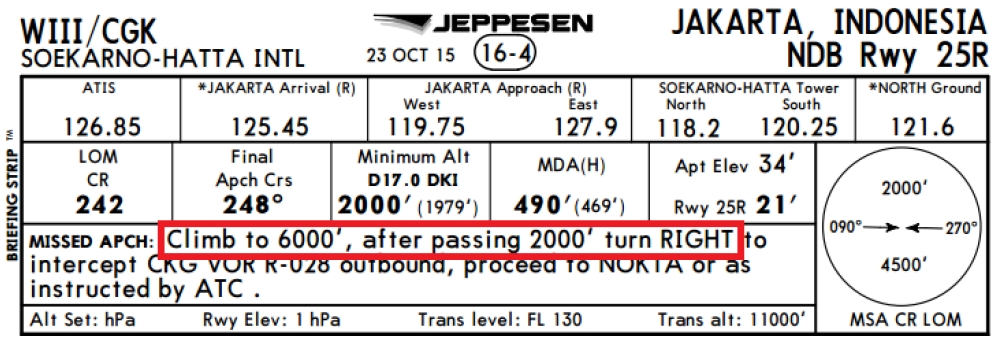
¶ Regulatory flight parameters
¶ Airspeed
The following airspeed table must be enforced during a missed approach.
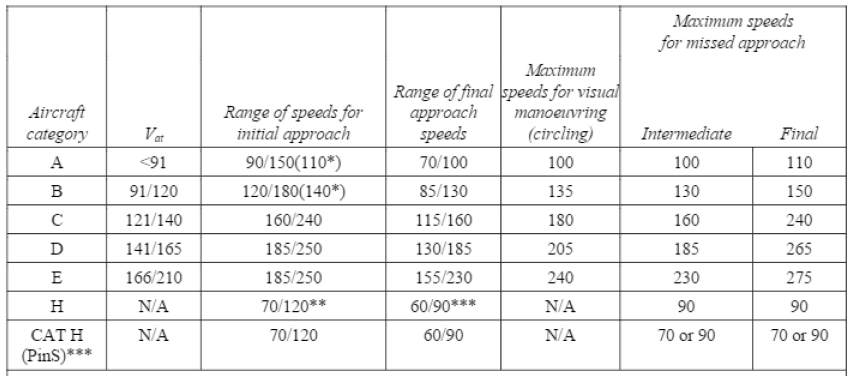
Missed approach procedures may be more restrictive than these airspeeds. Therefore, the pilot should review the following mention: "MAX xxx KTS"
¶ Bank angle
A minimum bank angle of 15° in average is required during a turning missed approach. This includes protection up to an omnidirectional wind of 30 knots.
¶ Climb gradient
The standard missed approach climb gradient is 2.5%. Where it is appropriate, ATS authority will establish parametric minima, and the (M)DA/H will depend on the capability of the aircraft.
The aircraft capability to be taken into account is in the one-engine inoperative scenario.
Example: ILS18 -- Chambéry LFLB.
Minima vary with aircraft one-engine inoperative climb gradient.
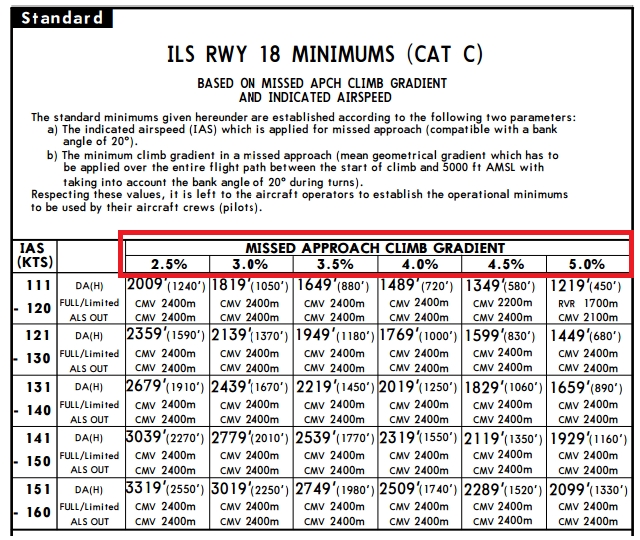
¶ Practical aspects
¶ Occurrence
There are several situations that lead to perform a go-around procedure:
- Visual references are not acquired at minima or passing the MAPt
- Approach is not stabilized (runway axis, descent path, speed)
- Runway is not clear of traffic or obstacles
- ATC will not issue landing clearance
- ATC will command a go-around for safety reasons
- Training
Remember: pilots are required to perform an immediate go-around when passing the MAPt or reaching the decision altitude/height.
About stabilization, operators will issue mandatory or recommended stabilization heights at which an aircraft must be configured for
landing, in good position with runway, at a correct airspeed. Deviation values will exist to tolerate parameter variations due to environmental factors. If one of these values is exceeded, a go-around must be initiated.
Here are some values extracted from a real aviation school:
- Stabilization height: 1000ft AGL under IMC / 500ft AGL under VMC
- Runway axis: 1 dot deviation on conventional approach / 0.5 dot on GNSS approach
- Descent path: 1 dot deviation above or below
- Airspeed: not below approach speed, no more than 5 knots in excess
¶ Initiate a go-around
Following the pilot's decision or the ATC's order to go-around, it is vital to establish a climb as fast as possible confirmed by:
- a relevant pitch value necessarily positive, near the takeoff standard setting
- a positive rate of climb.
It is critical to ensure that power/thrust will be available when you will pitch up the aircraft! Throttle must be set to takeoff setting at the same time. Failure to do so will result in:
- very low or no climb at all
- rapidly decreasing airspeed bringing the aircraft near stall.
¶ Aircraft management
Just after initiating the go-around, workload will be very high for multiple reasons:
- You will need to adjust pitch and power/thrust
- You will have to adjust your aircraft configuration
- You will need to fly the published missed approach
- You will have to communicate with ATC
Remember that airmanship is achieved in this order: FLY -- NAVIGATE -- COMMUNICATE
Since you had configured your aircraft for landing, you will need to configure it back to takeoff/climb position. This will take more or less resources depending on your aircraft complexity:
- Retract flaps if required
- Retract landing gear if possible
- Adjust power/thrust to normal climb power/thrust.
Then, consider your flight trajectory.
¶ Flight trajectory
Considering the definitions we established earlier, you should be concerned about your flightpath after having established clearly a positive climb.
The key to complete an IFR missed approach successfully is anticipation! You should review your trajectory during approach preparation and make sure you have in mind the first turn and altitude when starting the final approach phase.
Pay attention to ATC instructions that may differ from the published missed approach. Do not hesitate to step up and request to remain on the published missed approach if the workload is too high to manage new ATC instructions.
¶ Conclusion
Performing an instrument missed approach is more challenging than a visual missed approach. However, with a good flight preparation, a good review and anticipation during the approach phase of the key points of the procedure, it is not a difficult exercise.
- None
- ICAO Documentation 8168 - Aircraft Operations - Volume I - Flight Procedures - 6th Edition 2010
- VID 200696 - Creation
- VID 531824 - Wiki Integration
- VID 496402 - Wiki.js integration